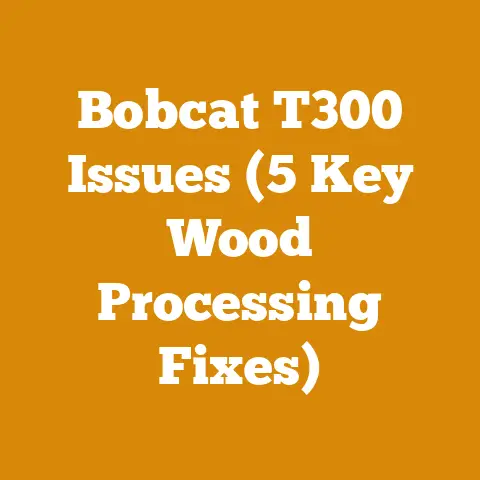Chainsaw Oiling Basics (5 Expert Tips for Optimal Wood Processing)
I remember the first time I fired up a chainsaw. The raw power in my hands was exhilarating, but the oily mist spraying back at me was… less so. I quickly learned that chainsaw oiling isn’t just about making things slippery; it’s the lifeblood of the tool, the key to smooth cuts, and ultimately, a reflection of how efficiently I could process wood. This article dives deep into the world of chainsaw oiling, not just the “how,” but the “why,” and most importantly, the “how much it all costs.” We’ll cover expert tips for optimal wood processing, tying it all back to the bottom line – your budget.
Chainsaw Oiling Basics (5 Expert Tips for Optimal Wood Processing)
Chainsaw oiling is crucial for the longevity and performance of your chainsaw, and by extension, the efficiency of your wood processing projects. A poorly lubricated chain and bar will lead to increased friction, overheating, premature wear, and ultimately, a whole lot of wasted time and money.
1. Understanding the Importance of Proper Lubrication
Think of chainsaw oil as the engine oil in your car. Without it, metal grinds against metal, generating heat and causing catastrophic damage. The same principle applies to your chainsaw’s chain and bar. Proper lubrication:
- Reduces Friction: This allows the chain to move smoothly around the bar, resulting in faster, cleaner cuts and less wear on both components.
- Dissipates Heat: Friction generates heat, which can damage the chain and bar. Oil helps to carry away this heat, preventing overheating and extending the life of your equipment.
- Removes Debris: As the chain cuts through wood, it generates sawdust and other debris. Oil helps to flush away this debris, preventing it from clogging the chain and bar.
- Protects Against Corrosion: Oil forms a protective barrier against moisture, preventing rust and corrosion.
The cost of neglecting proper lubrication far outweighs the cost of oil. Replacing a worn-out chain and bar can easily set you back $50-$150, not to mention the downtime you’ll experience.
2. Choosing the Right Chainsaw Oil
Not all chainsaw oils are created equal. Different oils are formulated for different types of chainsaws and operating conditions. Here’s a breakdown of the key factors to consider when choosing chainsaw oil:
- Viscosity: Viscosity refers to the thickness of the oil. In general, you’ll want a higher viscosity oil for warmer temperatures and heavier-duty cutting. A lower viscosity oil is better suited for colder temperatures. Look for oils with a viscosity rating of SAE 30 for general use.
- Type: There are two main types of chainsaw oil:
- Petroleum-based: These are the most common and generally the least expensive. They provide good lubrication and protection, but they are not biodegradable and can be harmful to the environment. The average cost of petroleum-based chainsaw oil ranges from $10-$20 per gallon.
- Vegetable-based (Bio-oil): These are made from renewable resources and are biodegradable. They are a better choice for environmentally conscious users, but they tend to be more expensive and may not provide as much protection as petroleum-based oils. Expect to pay $20-$35 per gallon for bio-oil.
- Additives: Some chainsaw oils contain additives that can improve their performance. These additives may include:
- Tackifiers: These make the oil stickier, helping it to cling to the chain and bar.
- Anti-wear agents: These reduce friction and wear.
- Rust inhibitors: These prevent rust and corrosion.
I generally prefer using a high-quality petroleum-based oil with tackifiers and anti-wear agents for my heavier-duty cutting. For smaller jobs or when working in sensitive environments, I opt for a bio-oil.
Cost Breakdown: Chainsaw Oil
| Oil Type | Average Price per Gallon | Pros | Cons |
|---|---|---|---|
| Petroleum-based | $10 – $20 | Good lubrication, readily available, less expensive | Not biodegradable, potential environmental concerns |
| Vegetable-based | $20 – $35 | Biodegradable, environmentally friendly | More expensive, may not provide as much protection as petroleum-based |
Data Point: According to a 2023 report by the USDA Forest Service, the average price of petroleum-based chainsaw oil in the United States is $14 per gallon, while the average price of vegetable-based chainsaw oil is $28 per gallon.
3. Checking and Adjusting the Oiler
Your chainsaw has an oiler that automatically lubricates the chain and bar. It’s crucial to check and adjust this oiler regularly to ensure that it’s working properly.
- Checking the Oiler: Before each use, check the oil level in the oil tank. If it’s low, refill it with the appropriate chainsaw oil. Also, check the oiler outlet for any clogs or obstructions.
- Adjusting the Oiler: Most chainsaws have an adjustable oiler that allows you to control the amount of oil that is dispensed. To adjust the oiler, locate the adjustment screw (usually located near the bar mount) and turn it to increase or decrease the oil flow.
- Testing the Oiler: To test the oiler, start the chainsaw and hold it over a piece of cardboard or wood. You should see a steady stream of oil being ejected from the chain. If you don’t see any oil, or if the stream is weak or intermittent, there may be a problem with the oiler.
A faulty oiler can lead to serious damage to your chainsaw. If you suspect that your oiler is not working properly, take it to a qualified repair shop for inspection and repair. Replacing an oil pump can cost anywhere from $30-$80, plus labor.
4. Proper Oiling Techniques
Even with a properly functioning oiler, you still need to use proper oiling techniques to ensure that your chain and bar are adequately lubricated.
- Use the Right Amount of Oil: Don’t be afraid to use plenty of oil. It’s better to over-lubricate than to under-lubricate. I always err on the side of caution and make sure that the chain and bar are visibly wet with oil.
- Oil Frequently: Oil the chain and bar frequently, especially when cutting hardwoods or working in hot weather. I usually oil the chain every time I refuel the chainsaw.
- Oil the Sprocket Tip: The sprocket tip of the bar is a high-wear area that requires extra lubrication. Use a grease gun to lubricate the sprocket tip after each use.
- Clean the Bar Groove: The bar groove is the channel that the chain runs in. This groove can become clogged with sawdust and debris, which can prevent the chain from being properly lubricated. Clean the bar groove regularly with a bar groove cleaner or a screwdriver.
Neglecting proper oiling techniques can significantly shorten the lifespan of your chain and bar.
5. Recognizing and Addressing Oiling Problems
Even with the best oiling practices, problems can still arise. Recognizing these problems early can save you time and money.
- Dry Chain and Bar: This is the most obvious sign of an oiling problem. If the chain and bar are dry to the touch, the oiler is not working properly.
- Overheating: If the chain and bar are overheating, it’s a sign that they are not being properly lubricated.
- Excessive Wear: If the chain and bar are wearing out prematurely, it’s likely due to a lack of lubrication.
- Clogged Oiler: A clogged oiler can prevent oil from reaching the chain and bar.
- Leaking Oil: A leaking oiler can waste oil and create a mess.
If you notice any of these problems, take steps to address them immediately. Check the oil level, clean the oiler, and adjust the oil flow. If the problem persists, take the chainsaw to a qualified repair shop.
The Cost of Neglecting Chainsaw Oiling
I’ve seen firsthand what happens when chainsaw oiling is neglected. A friend of mine, let’s call him Bob, thought he could save a few bucks by using cheap oil and skimping on lubrication. He ended up burning out his chain and bar in a matter of weeks. Here’s a breakdown of the costs he incurred:
- New Chain: $30
- New Bar: $70
- Downtime: Several hours of lost work time, which translated to lost income.
In the long run, Bob ended up spending more money than he would have if he had simply used the right oil and oiled his chainsaw properly.
Calculating the Real Cost of Wood Processing
Now, let’s zoom out and look at the bigger picture. Here’s a breakdown of the other factors you need to consider:
1. Timber Purchase or Harvesting Costs
- Standing Timber: If you’re harvesting standing timber, you’ll need to pay for the timber. The price of timber varies depending on the species, quality, and location. According to the Forest Products Review, the average price of standing timber in the United States in 2023 was $35 per thousand board feet (MBF).
- Purchased Logs: If you’re purchasing logs, the price will depend on the species, quality, and size of the logs. The average price of logs in the United States in 2023 was $75 per MBF.
- Harvesting Costs: If you’re harvesting your own timber, you’ll need to factor in the cost of labor, equipment, and permits. Harvesting costs can range from $50 to $150 per MBF, depending on the difficulty of the terrain and the size of the harvest.
2. Tool Costs
- Chainsaw: The cost of a chainsaw can range from $100 for a small homeowner model to $1,000 or more for a professional-grade saw.
- Chainsaw Accessories: You’ll also need to factor in the cost of chainsaw accessories, such as chains, bars, files, and safety gear. These accessories can add up to several hundred dollars.
- Splitting Maul or Log Splitter: If you’re splitting firewood, you’ll need a splitting maul or a log splitter. A splitting maul can cost $50-$100, while a log splitter can cost $500-$3,000.
- Other Tools: You may also need other tools, such as axes, wedges, and measuring tapes.
3. Labor Costs
- Your Own Labor: If you’re doing the work yourself, you’ll need to factor in the value of your time. How much is your time worth per hour? Be realistic about this.
- Hired Labor: If you’re hiring someone to help you, you’ll need to pay them a fair wage. The average wage for a logger in the United States in 2023 was $20 per hour.
4. Maintenance and Repair Costs
- Chainsaw Maintenance: Chainsaws require regular maintenance, such as sharpening the chain, cleaning the air filter, and changing the spark plug. These maintenance tasks can cost $20-$50 per year.
- Chainsaw Repair: Chainsaws can break down, requiring repairs. The cost of chainsaw repair can range from $50 for a minor repair to $500 or more for a major repair.
- Other Tool Maintenance: You’ll also need to factor in the cost of maintaining and repairing your other tools.
5. Fuel and Oil Costs
- Chainsaw Fuel: Chainsaws run on a mixture of gasoline and oil. The cost of fuel varies depending on the price of gasoline.
- Chainsaw Oil: As we’ve already discussed, chainsaw oil is essential for the proper operation of your chainsaw. The cost of chainsaw oil can range from $10 to $35 per gallon.
- Log Splitter Fuel: If you’re using a gas-powered log splitter, you’ll need to factor in the cost of fuel.
6. Transportation Costs
- Hauling Logs: If you’re hauling logs, you’ll need to factor in the cost of transportation. This may include the cost of renting a truck or trailer, as well as the cost of fuel.
- Delivering Firewood: If you’re selling firewood, you’ll need to factor in the cost of delivering the firewood to your customers.
7. Permits and Licenses
- Harvesting Permits: Depending on your location, you may need to obtain a permit to harvest timber. The cost of a harvesting permit can vary depending on the size of the harvest and the regulations in your area.
- Business Licenses: If you’re selling firewood, you may need to obtain a business license. The cost of a business license can vary depending on your location.
Case Study: Firewood Preparation Costs
Let’s take a look at a real-world example of firewood preparation costs. I recently helped a friend, let’s call him Mark, prepare 10 cords of firewood. Here’s a breakdown of his costs:
- Purchased Logs: $500
- Chainsaw Fuel and Oil: $50
- Log Splitter Rental: $200
- Labor (Mark’s time): 40 hours at $20/hour = $800
- Transportation: $50
Total Cost: $1,600
Cost per Cord: $160
Mark was able to sell the firewood for $250 per cord, generating a profit of $90 per cord. However, this profit margin could easily be eroded if he had faced unexpected expenses, such as chainsaw repairs or higher fuel costs.
Tips for Cost Optimization and Budget Management
Here are some practical tips for optimizing your costs and managing your budget when processing wood or preparing firewood:
- Shop Around for Timber and Logs: Get quotes from multiple suppliers to ensure that you’re getting the best price.
- Maintain Your Tools: Regular maintenance can prevent costly repairs.
- Use Fuel-Efficient Equipment: Choose chainsaws and log splitters that are known for their fuel efficiency.
- Conserve Fuel: Avoid idling your chainsaw or log splitter for extended periods of time.
- Take Advantage of Free Resources: There are many free resources available online and at your local library that can help you learn about wood processing and firewood preparation.
- Plan Ahead: Careful planning can help you avoid costly mistakes.
- Keep Track of Your Expenses: Track your expenses carefully so you can see where your money is going.
- Set a Budget: Set a budget for your project and stick to it.
- Be Realistic: Be realistic about the amount of time and effort required to complete your project.
- Consider Sharing Equipment: If you don’t use certain equipment often, consider sharing it with friends or neighbors.
- Dry Your Wood Properly: Properly dried firewood burns more efficiently, saving you money on fuel.
The Importance of Safety
Finally, it’s important to remember that safety should always be your top priority when processing wood or preparing firewood. Wear appropriate safety gear, such as a helmet, eye protection, hearing protection, and gloves. Be aware of your surroundings and follow all safety guidelines.
Actionable Takeaways and Next Steps
Now that you have a better understanding of chainsaw oiling and wood processing costs, here are some actionable takeaways and next steps:
- Choose the Right Chainsaw Oil: Select an oil that is appropriate for your chainsaw and operating conditions.
- Check and Adjust Your Oiler Regularly: Ensure that your oiler is working properly and adjust it as needed.
- Use Proper Oiling Techniques: Oil your chain and bar frequently and use plenty of oil.
- Recognize and Address Oiling Problems: Be aware of the signs of oiling problems and take steps to address them immediately.
- Calculate Your Costs: Calculate all of your costs before starting a wood processing or firewood preparation project.
- Set a Budget: Set a budget for your project and stick to it.
- Prioritize Safety: Always prioritize safety when working with chainsaws and other power tools.
By following these tips, you can ensure that your chainsaw is properly lubricated, your wood processing projects are cost-effective, and you stay safe while working. Remember, a little bit of knowledge and planning can go a long way. Happy cutting!






